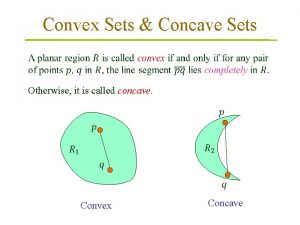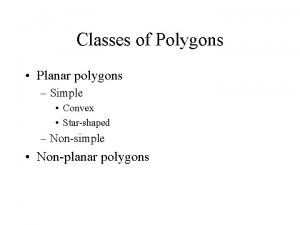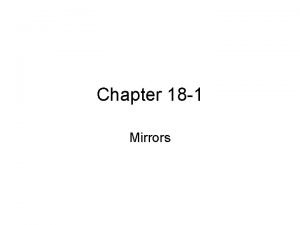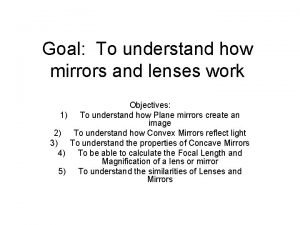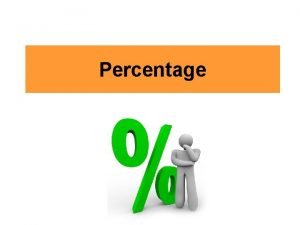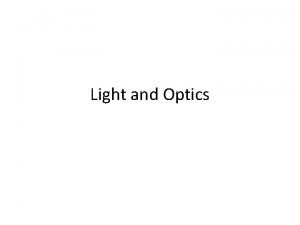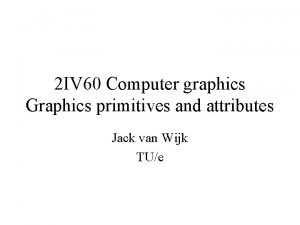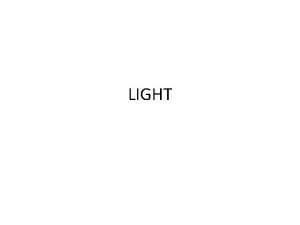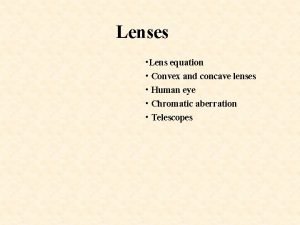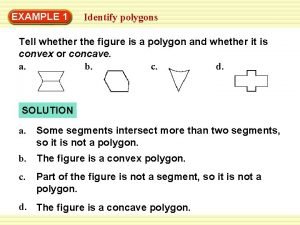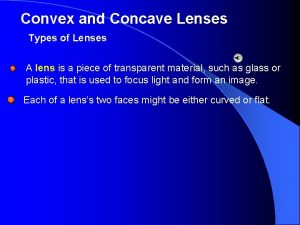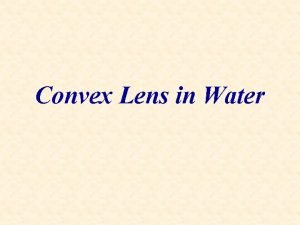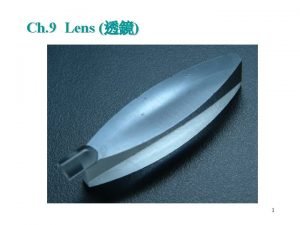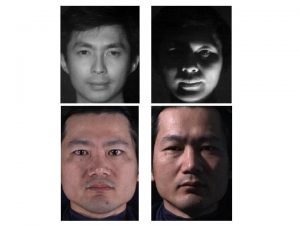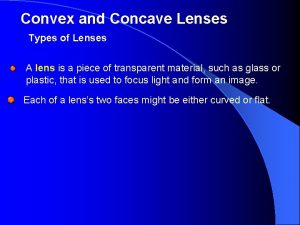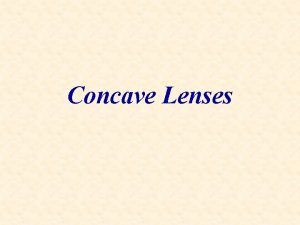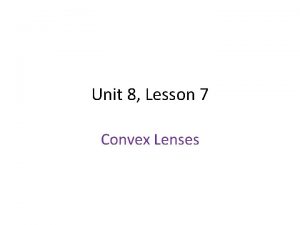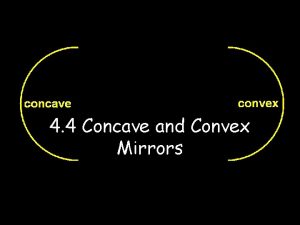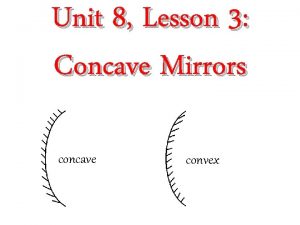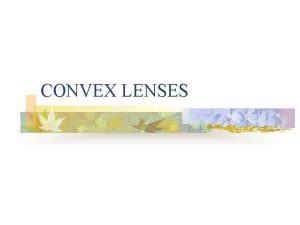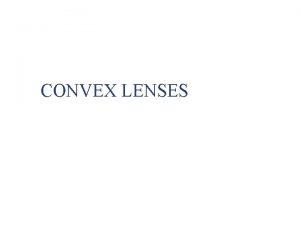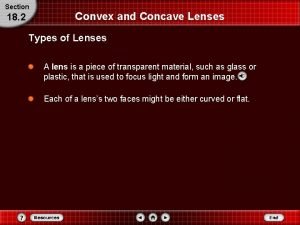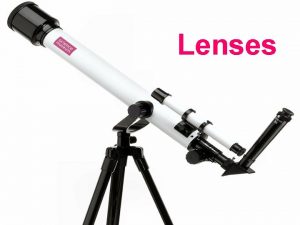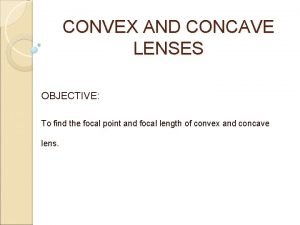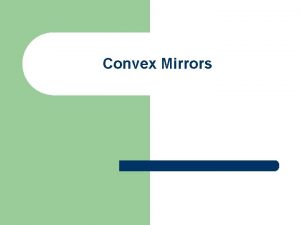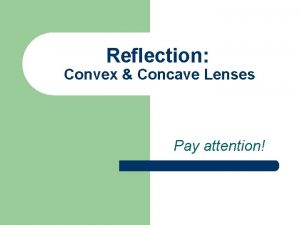Convex and Concave Lenses Types of Lenses A





















- Slides: 21

Convex and Concave Lenses Types of Lenses A lens is a piece of transparent material, such as glass or plastic, that is used to focus light and form an image. Each of a lens’s two faces might be either curved or flat.

Convex and Concave Lenses Types of Lenses The lens shown in the figure is called a convex lens because it is thicker at the center than at the edges. A convex lens often is called a converging lens because when surrounded by material with a lower index of refraction, it refracts parallel light rays so that the rays meet at a point.

Convex and Concave Lenses Types of Lenses The lens shown in the figure is called a concave lens because it is thinner in the middle than at the edges. A concave lens often is called a diverging lens because when surrounded by material with a lower index of refraction, rays passing through it spread out.

Ray diagrams for lenses Ray diagrams are drawings of the different situations for lenses. v For the ray diagrams, assume that the lenses are thin. v

Converging Lenses Principal focus or Focal point Principal axis Optical centre Focal plane Focal length

Ray Diagrams F F

Convex and Concave Lenses Convex Lenses and Real Images Paper can be ignited by producing a real image of the Sun on the paper. The rays of the Sun are almost exactly parallel when they reach Earth.

Convex Lenses and Real Images After being refracted by the lens, the rays converge at the focal point, F, of the lens. The figure shows two focal points, one on each side of the lens. You could turn the lens around, and it will work the same.

Ray diagrams for a double convex lens l Object is at infinity F

Object beyond 2 F F 2 F 2 F

Object at 2 F 2 F 2 F

Object between F and 2 F F 2 F

Object at F F F

Object between F and the lens F F

Images Formed by Lens Object distance Type of image Uses u= Inverted, smaller, real Telescope u > 2 f Inverted, smaller, real Camera, eye u = 2 f Inverted, same size, real Photocopier f < u < 2 f Inverted, magnified, real Projector u=f upright, magnified, real Spotlight u<f upright, magnified, virtual Magnifying glass

Lens Equations The thin lens equation relates the focal length of a spherical thin lens to the object position and the image position. The inverse of the focal length of a spherical lens is equal to the sum of the inverses of the image position and the object position.

Thin Lens Equation The thin lens equation is stated as follows: where do is the distance (measured along the axis) from the object to the center of the lens di is the distance (measured along the axis) from the image to the center of the lens f is the focal length of the lens The expression 1/f is called the power of a lens. It is measured in Diopters, where 1 D = 1 m-1.

Concave Lenses A concave lens causes all rays to diverge. The figure shows how such a lens forms a virtual image.

Concave Lenses The image is located at the point from where the two rays apparently diverge. The image also is upright and smaller compared to the object

Convex and Concave Lenses Ray 1 approaches the lens parallel to the principal axis, and leaves the lens along a line that extends back through the focal point. Ray 2 approaches the lens as if it is going to pass through the focal point on the opposite side, and leaves the lens parallel to the principal axis.

Concave Lenses The sight lines of rays 1 and 2 intersect on the same side of the lens as the object. Because the rays diverge, they produce a virtual image.
 Polygons definition
Polygons definition Convex and concave polygons
Convex and concave polygons Macam macam rabun
Macam macam rabun Convex and concave
Convex and concave Polygon convexity
Polygon convexity A flat smooth mirror
A flat smooth mirror Concave and convex mirror
Concave and convex mirror A quadrilateral
A quadrilateral Properties of lights
Properties of lights Filled area primitives in computer graphics
Filled area primitives in computer graphics Types of polygons 1-20
Types of polygons 1-20 Convex vs concave teeth
Convex vs concave teeth A lens that curve outwards and are fatter in the middle
A lens that curve outwards and are fatter in the middle Concave lens simulation
Concave lens simulation Movement physiology
Movement physiology Concave heptagon
Concave heptagon Radioulnar proximal
Radioulnar proximal Concave vs convex polygon
Concave vs convex polygon Covex and concave
Covex and concave Concave lens in water
Concave lens in water Focal length formula
Focal length formula Acrominoclavicular
Acrominoclavicular



